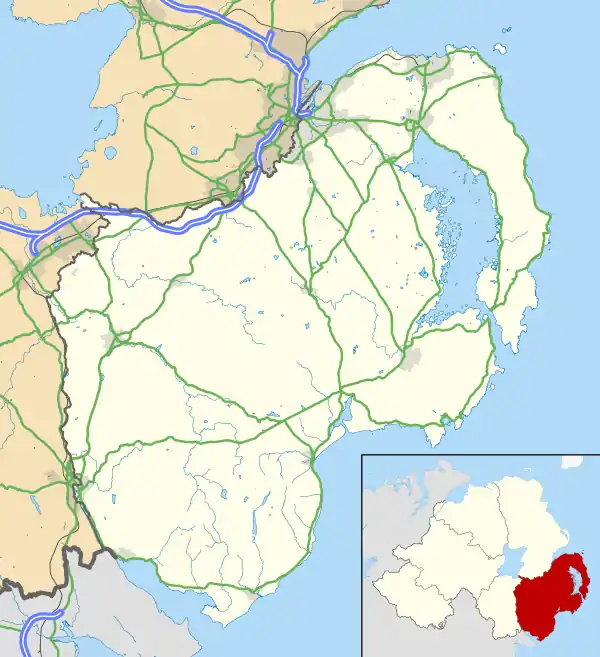Bleary
Bleary (likely from Irish: Bladhraigh)[1] is a small village and townland in County Down,[1][2] Northern Ireland. It is near the County Armagh border and the settlements of Craigavon, Lurgan and Portadown. In the 2011 Census its population was counted as part of Craigavon.[3] It lies within the Armagh City, Banbridge and Craigavon area.
Bleary
| |
|---|---|
 Bleary Location within County Down | |
| Population | 1,009 (estimate based on 2011 census) |
| Irish grid reference | J073540 |
| • Belfast | 24 mi (39 km) |
| District | |
| County | |
| Country | Northern Ireland |
| Sovereign state | United Kingdom |
| Post town | CRAIGAVON |
| Postcode district | BT63 BT66 |
| Dialling code | 028 |
| UK Parliament | |
| NI Assembly | |
| Website | www.craigavon.gov.uk |
History
The Troubles
- 18 June 1972 - Three British soldiers (Arthur McMillan (aged 37), Ian Mutch (aged 31) and Colin Leslie (aged 26)) were killed in an IRA booby-trap bomb attack. The bomb had been left in a derelict house in Bleary.
- 27 April 1975 - Loyalists shot dead three people in Bleary Darts Club. See Bleary Darts Club shooting
- 28 October 1993 - The UVF shot dead two Catholic brothers (Gerrard Cairns, 22, and Rory Cairns, 18) at their home in front of their eleven-year-old sister in Bleary, County Down.
Education
- Bleary Primary School [4]
Demography
2011 Census
On Census day (27 March 2011) there were 1,009 people living in Bleary.[5]
- 51.5% belong to or were brought up in a 'Protestant and Other Christian (including Christian related)' religion and 40.6% belong to or were brought up in the Catholic religion.
- 53.6% indicated that they had a British national identity, 20.4% had an Irish national identity, and 32.4% had a Northern Irish national identity.
There were 4,081 people living in the Bleary ward.[6]
- 73.1% belong to or were brought up in a 'Protestant and Other Christian (including Christian related)' religion and 19.9% belong to or were brought up in the Catholic religion.
- 70.65% indicated that they had a British national identity, 11.43% had an Irish national identity, and 27.17% had a Northern Irish national identity.
References
- Placenames NI
- Placenames Database of Ireland
- "Archived copy" (PDF). Archived from the original (PDF) on 4 March 2016. Retrieved 16 September 2016.
{{cite web}}: CS1 maint: archived copy as title (link) - "Bleary Primary School, Craigavon".
- https://www.ninis2.nisra.gov.uk/public/AreaProfileReportViewer.aspx?FromAPAddressMulipleRecords=Bleary@Exact%20match%20of%20location%20name:%20@Exact%20Match%20Of%20Location%20Name:%20%20Bleary@23?
- https://www.ninis2.nisra.gov.uk/public/AreaProfileReportViewer.aspx?FromAPAddressMulipleRecords=Bleary@Exact%20match%20of%20location%20name:%20@Exact%20Match%20Of%20Location%20Name:%20%20Bleary@4?
This article is issued from Wikipedia. The text is licensed under Creative Commons - Attribution - Sharealike. Additional terms may apply for the media files.
